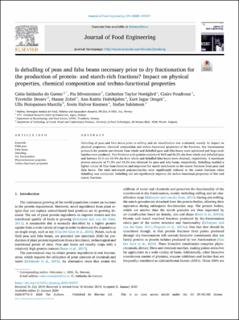| dc.contributor.author | do Carmo, Cátia Saldanha | |
| dc.contributor.author | Silventoinen, Pia | |
| dc.contributor.author | Nordgård, Catherine Taylor | |
| dc.contributor.author | Poudroux, Claire | |
| dc.contributor.author | Dessev, Tzevetelin | |
| dc.contributor.author | Zobel, Hanne | |
| dc.contributor.author | Holtekjølen, Ann Katrin | |
| dc.contributor.author | Draget, Kurt Ingar | |
| dc.contributor.author | Holopainen-Mantila, Ulla | |
| dc.contributor.author | Knutsen, Svein Halvor | |
| dc.contributor.author | Sahlstrøm, Stefan | |
| dc.date.accessioned | 2020-03-12T12:18:24Z | |
| dc.date.available | 2020-03-12T12:18:24Z | |
| dc.date.created | 2020-01-22T13:52:47Z | |
| dc.date.issued | 2020 | |
| dc.identifier.issn | 0260-8774 | |
| dc.identifier.uri | https://hdl.handle.net/11250/2646576 | |
| dc.description.abstract | Dehulling of peas and faba beans prior to milling and air classification was evaluated, namely its impact on physical properties, chemical composition and techno-functional properties of the fractions. Dry fractionation protocols for protein enrichment from whole and dehulled peas and faba beans were optimized and large-scale batches were produced. Fine fractions with protein contents of 44.0 and 46.2% dm from whole and dehulled peas and between 60.0 and 60.9% dm from whole and dehulled faba beans were obtained, respectively. A maximum protein recovery of 71.3% and 49.2% was obtained for peas and faba beans, respectively. Dehulling enabled a lighter colour of faba bean fractions and improved the starch enrichment in the coarse fractions from peas and faba beans. The total non-starch polysaccharides were significantly reduced in the coarse fractions when dehulling was conducted. Dehulling did not significantly improve the techno-functional properties of fine and coarse fractions. | |
| dc.language.iso | eng | |
| dc.title | Is dehulling of peas and faba beans necessary prior to dry fractionation for the production of protein- and starch-rich fractions? Impact on physical properties, chemical composition and techno-functional properties | |
| dc.type | Peer reviewed | |
| dc.type | Journal article | |
| dc.description.version | publishedVersion | |
| dc.source.journal | Journal of Food Engineering | |
| dc.identifier.doi | 10.1016/j.jfoodeng.2020.109937 | |
| dc.identifier.cristin | 1780109 | |
| dc.relation.project | Norges forskningsråd: 267858 | |
| cristin.ispublished | true | |
| cristin.fulltext | original | |
| cristin.qualitycode | 1 | |
